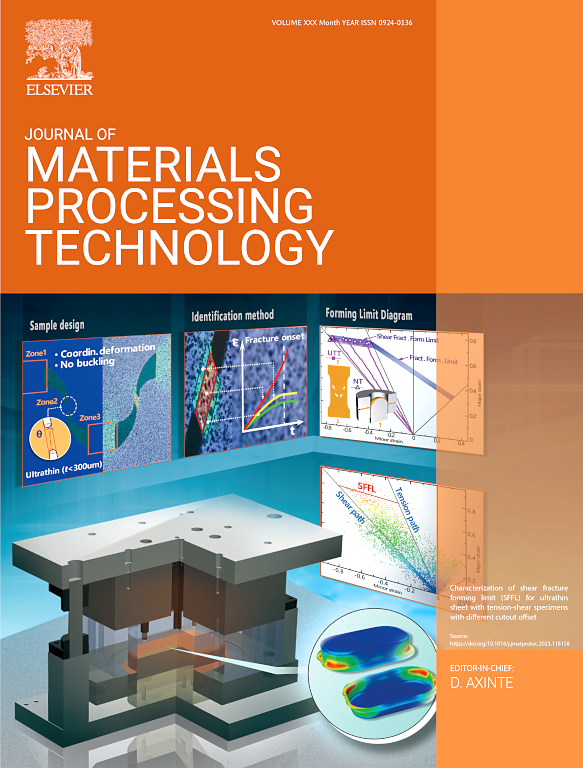在射频(RF)域对微型线切割工艺特征进行机上评估:在多物理过程中实现经济高效的数据收集
IF 6.7
2区 材料科学
Q1 ENGINEERING, INDUSTRIAL
Journal of Materials Processing Technology
Pub Date : 2024-11-14
DOI:10.1016/j.jmatprotec.2024.118663
引用次数: 0
摘要
在数字化日益发展的时代,中小型企业(SMEs)需要具有成本效益的数据采集技术,以实现生产过程的制造数据采集。在高端微型部件(如燃油喷嘴以及汽车和航空航天领域的精密部件)中采用微型放电加工(micro-EDM)等电物理过程时,这种需求会进一步增加。为了获得工艺信息,人们已经做出了许多努力,包括使用电气和声学监测、基于人工智能和多物理场的模型以及基础物理实验。所有上述技术都有助于更好地了解微型放电加工过程中的放电行为。为了弥补这一不足,本文研究了射频(RF)领域中的微型线切割过程特征,并因此提出了基于射频的策略,作为一种低成本、非侵入性的过程监控技术。本文对放电加工过程中的辐射源和潜在影响因素进行了研究。首先,通过分析不同脉冲波形的不同放电阶段的监测射频信号,研究放电加工中的射频机制。通过分析,建立了相应的等效射频辐射模型。其次,通过实验设计,在时域和频域上探讨了不同加工参数、介质、放电状态、监测设备和工件材料对射频信号的影响。结果表明,只有与击穿电压和间隙电流相关的参数会影响射频强度,但加工参数对辐射频谱的影响不大。电介质和工件材料对辐射行为的影响主要与其相应的等效电阻有关。在监测射频信号方面,放电脉冲和天线设备都存在显著差异。此外,还在两种应用场景下对射频策略的可监测性进行了评估。通过研究放电加工中的射频信号,有望为放电状态监测提供一种无创、无干扰和低成本的方法。本文章由计算机程序翻译,如有差异,请以英文原文为准。
On-machine evaluation of micro-EDM process signature in radio frequency (RF) domain: A step towards cost-effective data collection in a multiphysical process
In the growing age of digitization, there is a need for cost-effective data collection techniques to enable manufacturing data collection of production processes in small and medium scale enterprises (SMEs). This goes further where electrophysical processes, such as micro electrical discharge machining (micro-EDM) are employed in high-end micro-components such as fuel injection nozzles and precision components for automotive and aerospace sectors. There have been several efforts to get process information using electrical and acoustic monitoring, AI-based and multiphysics models, and fundamental physics experiments. All aforementioned techniques have contributed to improving understanding of the discharge behaviour in micro-EDM processes. However, they are all expensive and invasive in nature, thereby limiting their application for SMEs in enabling digitalisation of process-chain involving micro-EDM process.
To address this gap, this paper investigates micro-EDM process signature in radio frequency (RF) domain and hence RF-based strategy is proposed as a low-cost and non-invasive process monitoring technique. Research is conducted to investigate the radiation sources and potential influencing factors during the EDM process. First, the RF mechanism in EDM is examined by analysing the monitored RF signals across different discharge stages of various pulse waveforms. From this analysis, the corresponding equivalent RF radiation models are established. Second, through an experimental design, the impact of different machining parameters, dielectric fluids, discharge states, monitoring equipment, and workpiece materials on RF signals are explored in both the time and frequency domains. The results indicate that only parameters related to breakdown voltage and gap current affect RF intensity, however, machining parameters show to be not significant on the radiation spectrum. The influence of dielectrics and workpiece materials on radiation behaviour is primarily associated with their corresponding equivalent resistance. Notable differences in both discharge pulses and antenna devices in monitoring RF signals are observed. Additionally, the monitorability of RF strategy is also evaluated under two application scenarios. By investigating the RF signals in EDM, it is expected to provide a non-invasive, interference-free, and low-cost method for discharge state monitoring.
求助全文
通过发布文献求助,成功后即可免费获取论文全文。
去求助
来源期刊

Journal of Materials Processing Technology
工程技术-材料科学:综合
CiteScore
12.60
自引率
4.80%
发文量
403
审稿时长
29 days
期刊介绍:
The Journal of Materials Processing Technology covers the processing techniques used in manufacturing components from metals and other materials. The journal aims to publish full research papers of original, significant and rigorous work and so to contribute to increased production efficiency and improved component performance.
Areas of interest to the journal include:
• Casting, forming and machining
• Additive processing and joining technologies
• The evolution of material properties under the specific conditions met in manufacturing processes
• Surface engineering when it relates specifically to a manufacturing process
• Design and behavior of equipment and tools.
 求助内容:
求助内容: 应助结果提醒方式:
应助结果提醒方式:


